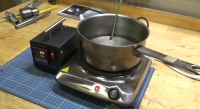This stand alone PID controlled interface allows users to plug in just about any heating device that is normally controlled from mains power and set it to a precise temperature. I keep two single burner hotplates in my shop for heating up anodising dyes, glues and copper etching solutions however the thermostats in these hotplates are not very accurate and the hotplates themselves have a lot of thermal mass and consequently, a lot of thermal inertia. I recently purchased the chemicals to do parker phosphating in my shop but it requires three different heated solutions. The first is a boiling water bath. No problem, just heat up a large stainless steel pot of water on the first hotplate. The parkerising solution though has to be heated to 96C. This is difficult to do on one of the standard hotplates without a lot of trial and error. The last stage of the parkerising process is to place the article being treated into a heated pot of a soluble oil at 60C.
I wanted to be able to control the hotplate with a PID controller kit consisting of the PID controller, a solid state relay and a K type thermocouple.
The PID controller and the SSR are fitted into a small box with the thermocouple being immersed in the fluid being heated. The video shows how I water proofed the thermocouple and how the box was made. The whole contraption could also be used to control a hot air gun, a sandwich toaster, a domestic toaster oven or whatever. It just depends on how you package the thermocouple.
Cheers,
Preso


 LinkBack URL
LinkBack URL About LinkBacks
About LinkBacks


 Reply With Quote
Reply With Quote




Bookmarks